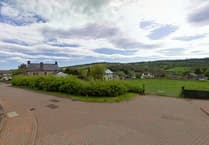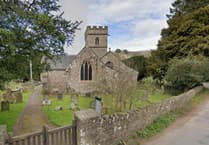Next Thursday the new Jesse Window, widely regarded as the most important work of religious art in Wales since World War II, will be unveiled at St Mary’s Priory Church in Abergavenny.
Vicar of Abergavenny Fr Mark Soady, despite having followed every stage of its creation, says that when he saw the finished work for the first time last week his heart skipped a beat.
Ironically the unveiling ceremony, attended by HRH the Prince of Wales, will be the first chance for York-based designer Helen Whittaker to see her ‘labour of love’ in situ.
But there’s nothing to stop members of the public stepping into St Mary’s for a ‘sneak preview’.
The window in the Lewis Chapel will complete the world-famous Jesse figure, which once formed the base of an intricate and elaborate construction depicting the lineage of Jesus Christ from Jesse, father of King David.
It has been created in memory of the late Dean Jeremy Winston, who served as Vicar of Abergavenny for 18 years.
Fr Jeremy is subtly represented in the window by a sparrow. One of his favourite poems, A Sparrow’s Flight by Lord Hailsham, was read at his funeral service.
There is something in the new window to interest everyone from international art experts to local schoolchildren.
The window follows a narrative, leading from the massive wooden Jesse figure, which will in due course be positioned beneath it, to the Virgin Mary and the Christ child.
The composition and position of the many elements within the design is controlled by a geometrical scheme of overlapping circles which spread out from the heart of Christ.
Beneath the Virgin and Child sits King Solomon and below him his father King David.
Flanking King David are Ruth, his great grandmother and Bathsheba, his wife.
To the left of Solomon are Zadok ‘teacher of righteousness’ and Nathan the prophet.
Standing to left and right in the outer lights of the window are Adam and Abraham, Isaiah and Daniel, Moses and Elijah.
In the centre, around and above the Virgin and Child are roundels containing images representing aspects of the lives of seven Celtic saints – David, Winifred, Beuno Gildas, Teilo, Non and Padarn.
St David is set against daffodils, the other saints surrounded by fruits such as grapes, apricots and plums representing the Fruits of the Holy Spirit.
All but two of the traceries contain images connected with the Advent Jesse – a symbolic narrative drawn from scripture, which spells out the 25 days of Advent leading to Christmas.
At the base of the window depictions of medicinal herbs form a link to the Abbott’s Garden outside – plants with healing qualities such as St Johns wort, comfrey, feverfew, lavender, chamomile, borage, tansy and lemon balm.
The intricate work of art was pieced together at Barley Studio in York where Helen Whittaker is Creative Director.
Helen is highly regarded for her new stained glass windows, restoration painting and architectural sculpture in glass and copper.
She has an MA in Visual, Islamic and Traditional Arts from the Prince of Wales’s Institute of Architecture, writing her thesis on Jesse trees.
“It’s strange to think other people will see the completed work before I do – but I’m very excited,” she said.
”I wanted my design to follow the Jesse traditions but with a modern edge.
“I like using geometry and block colours. I also like the tension that is created in medieval masterpieces, where some figures are looking at each other while others are looking out at the viewer.
“An important part of the brief was the inclusion of the two women, Ruth and Bathsheba. It is very unusual for a Jesse window to include women in fact I’m not aware of another anywhere in the world.
“I also loved the fact that the design incorporated the Celtic saints, the Fruits of the Holy Spirit like grapes, plums and apricots and the medicinal plants from the Abbott’s Garden.
“I did a lot of research into it all but it was a real labour of love for me. I don’t know of any other Jesse window including these themes.”
And the more you study the window, the more you discover - a rare day-time moth recently found in Wales, a bumble bee feeding from the flowers…
“I have actually done a larger window at Westminster Abbey - but it was not as detailed as this. It’s been a really interesting project.”
Helen’s co-director at Barley Studio, Keith Barley, has been in Abergavenny supervising the installation.
“Most church windows made today are in memory of a specific donor and their family, which makes this example very rare. And most Jesse windows are much smaller, with a much simpler design,” he explained.
Keith and Helen travelled to Germany to select the sheets of coloured glass needed for the project.
Back at the studio the glass is cut to the required shapes to fit the design, rather like a dressmaker would cut cloth to fit a pattern.
The window is painstakingly pieced together on a light table, with individual pieces hand-painted, stained and etched.
One unique aspect of the St Mary’s Jesse window is that the lower quarter was made using mouth-blown uv glass.
Glass with uv protection is normally used as a separate layer from the stained glass – rather like a form of double glazing. But because this very expensive antique glass has UV protection within it, it was hand-painted and positioned within the leading.
“The first impression is of colour and form and that draws you in to look closer and pick out all the interesting iconography,” said Keith.
“Everything is positioned within a strict geometric background but the poses are active – Daniel’s lion draped on a branch and so on.
“The inclusion of stories related to the Welsh saints is such fun - the dragon roped to a rock, the tale of King Arthur’s envy of the Bishop’s cloak which ends with him disappearing into the earth wielding up a sword!”
Members of staff at Barley Studio posed for the figures.
“I don’t know how often I had to take off my socks to model feet!” he said.
You could return to the window again and again and see something different every time. And you’ll have plenty of opportunities to do so. The glass is expected to last five hundred years - although the leading may need attention in two hundred!
Fr Mark Soady thinks the window fits the brief perfectly – having ‘a distinct medieval feel, with a modern twist’.
The interconnection of all of the elements draws the viewer in to ‘read’ and understand the characters and their stories.
“There are lots of hidden elements and the traceries which Helen has pulled out from the Jesse Advent calendar add some real fun,” he said.
“I have already preached three sermons on the topic and there will be plenty more in the future!
“Centuries ago stained glass windows were placed in churches to provide a narrative for people who couldn’t read or write and this is a work of art with an educational purpose too. We’re expecting many groups from schools and colleges to come and study it.”
The Jesse window is part of a rolling programme of work connected to the Lewis Chapel.
The next step will be moving the wooden Jesse figure to the bottom of the window. Light and humidity testing is currently being undertaken to determine the optimum position.
There are also plans to design three smaller stained glass windows for the chapel and to have the chapel itself enclosed in etched glass panelling.
Fr Mark also hopes there will be good news soon about an award from the Chancellor’s Church Roof Fund to restore the chapel roof.
* St Mary’s Priory Church was founded as a Benedictine Priory in 1087.
* The Very Revd Jeremy Winston was Vicar of Abergavenny for 18 years until September 2011, when he was installed as Dean of Monmouth at Newport Cathedral. Two months later he died aged 57. He was a towering figure, both spiritually and physically, who drove forward the transformation of St Mary’s Priory Church into one which has been described as ‘The Westminster Abbey of Wales’.
The window project in his memory has been steered by the St Mary’s Winston Appeal Committee.
* ‘Jesse figures’ and ‘Jesse trees’ are not uncommon in stone and stained glass, but Abergavenny’s is the only one in wood to be found in the UK and probably the world.
Carved from one solid piece of oak, most likely in the 15th century, it was originally highly coloured and depicted all the Davidic kings and descendants, surmounted by the figures of Mary and the Child, and Christ in glory. Latest thought estimates the height of the ‘tree’ growing from Jesse’s side to have been between 25ft and 30ft.
* The Lewis Chapel, where the window has been installed, is dedicated to Dr David Lewis (died 1584) a local man who achieved fame by becoming an advisor to Queen Elizabeth I.




